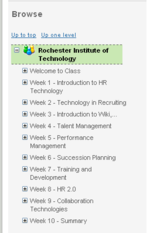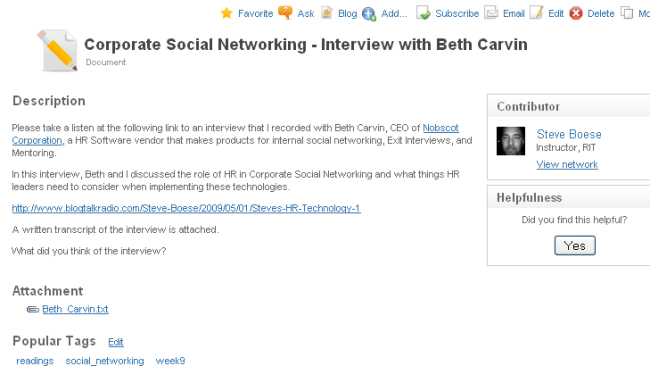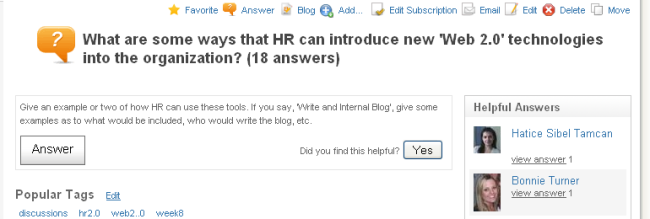For the current edition of the HR Technology class we were fortunate enough to use the Tomoye Ecco Community platform as a basis for many class activities, and all class discussions.
The Tomoye Community platform is a basis for sharing and collaborating on content (documents, images, video), asking and answering questions, and finding and accessing organization expertise. Content can can be organized by main topic, then further identified and described with user-defined tags. Users can comment on or ask a question about any piece of content in the Community.
In class, we took advantage of these capabilities in several ways:
Organization
The Course content was organized into Topics, one per week, and all readings, assignments, discussion questions were placed in the Week's Topic, as well as being tagged as a 'reading', 'project', etc. This way students could easily see all content in a chronological manner, or by type (by doing an easy tag search, or using the tag cloud). This made content more accessible and consumable for students, and did not necessarily 'force' them to access content in only one prescribed manner.
way students could easily see all content in a chronological manner, or by type (by doing an easy tag search, or using the tag cloud). This made content more accessible and consumable for students, and did not necessarily 'force' them to access content in only one prescribed manner.
Content
All class assigned readings were uploaded to the community as 'Documnents', but beyond simply loading a file, I was able to introduce the reading, set some context, and even offer some of my observations on the content. Sometimes I asked a specific question or two, and other times simply asked the students to share their comments and observations about the reading. Here again the ability to post comments or ask questions directly tied to the content item was very valuable, and a great feature for the class.

I also used the Documents feature to load images, usually diagrams or charts taken from presentation material from the 'in-person' version of the class. This worked well, as the ability to set context and describe the material in the image was key to ensure better student understanding.
Discussions
Each week there was at least one 'required' class discussion topic that I entered as a 'Question' in that
week's topic.

Students were asked to provide their views on the question, and to comment and discuss their answers with each other. Here the class utilized one of the powerful features of Tomoye, the ability to mark an answer as 'Helpful'. This is a simple, yet effective mechanism for bubbling good content to the top, and for building the reputation of community members. In a short class, community ratings and recommended members have fairly limited utility, as really more time needs to pass and more discussions created for this feature to be really powerful.
Overall Thoughts
First, the Tomoye Community was vastly superior to the course management system that is available through my school in the areas of content management, discussions, and organization and locating information. While all these are possible in a traditional CMS, the features of Tomoye like tagging, commenting, asking questions, and rating are a major improvement and enhancement. The visibility in comments and discussions to all student contributions is also far superior in Tomoye to the 'classic' threaded forum style in the CMS.
Certainly Tomoye, or any other community not designed for course management can't completely replace functions like online grading, online live quizzing, and perhaps even private exchanges between and individual student and the instructor.
But going forward I see huge potential for using a platform like Tomoye not just for an individual course as I did this quarter, but as an overall community platform for the entire program. I can envision a community that is set up for all enrolled students, faculty, staff, and even alumni. There could be separate content areas or topics for each individual course containing overview material, sample course content, reviews from students, faculty bios, and areas where prospective, current, and past students could ask questions and have discussions. Additionally, topics can be created for overview information, coming events, and perhaps job opportunities posted by alumni or friends of the program. What I am thinking about is sort of a hybrid between traditional 'alumni' networks and an active student network.
To close, we had a great experience using Tomoye in class, and many thanks to the great folks at Tomoye, especially Eric Sauve and Kathleen Brault, I am truly appreciative of the fantastic support in this initiative.